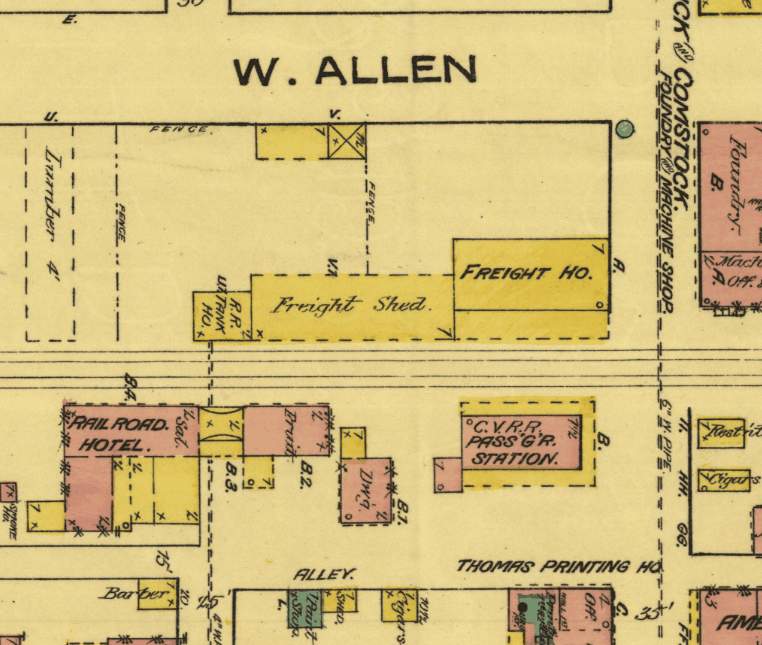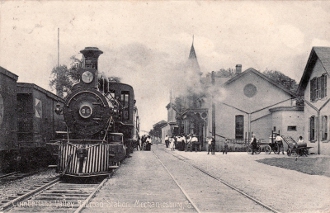~ THE CUMBERLAND VALLEY RAILROAD & MECHANICSBURG ~
April 2, 1831, the Pennsylvania Assembly passed an act to incorporate the Cumberland Valley Railroad,
to run between Carlisle and Bridgeport (now Lemoyne). This was among the first railroad charters in the
country. The company failed to raise the necessary capital, and was dormant until 1835. April 10, 1835,
the charter was revised to run between Chambersburg and Bridgeport. Pennsylvania was the bread basket
of the nation at the time, and including most of the Cumberland Valley piqued the interest of
Philadelphia merchants, hoping to divert grain, whiskey, and iron shipments from Baltimore to
Philadelphia. Their support helped raise enough capital to begin construction, and August 19, 1837,
the first excursion was run from Carlisle to White Hill, with horse drawn transportation across the
Market Street Bridge to Harrisburg. By the end of 1837, the line was completed between Bridgeport and
Chambersburg, home of corporate headquarters and primary maintenance facilities. Mechanicsburg had a
fuel wood and water stop from the beginning, probably on the property where the freight station is now.
The bridge to Harrisburg, delayed by a national financial collapse in 1837, was opened January 16, 1839.
h connections to two other lines, this allowed rail travel through Lancaster to Philadelphia.
At this time, the favorite passenger route from Philadelphia to Pittsburgh became the railroads to
Chambersburg, and stage coach from there to Pittsburgh. As the evening stage coach from Pittsburgh to
Chambersburg arrived about midnight, the train to Harrisburg left about 1:00 AM. The CVRR converted a
passenger car to folding sleeping berths, inventing what is believed to be the first sleeping car.
It was popular enough to build a second sleeping car. When the Pennsylvania Railroad neared Pittsburgh
in the 1850s, the stage coach to Chambersburg became obsolete, as did the sleeping cars.
In 1844, the bridge to Harrisburg caught fire from a locomotive spark, and was destroyed,
threatening the fledgling railroad with bankruptcy. The Pennsylvania Assembly donated its stock,
worth several thousand dollars, to rebuild the bridge. In fear of another fire, locomotives were banned
from the bridge. Gravity moved cars downhill from Bridgeport to Harrisburg, and horses or mules were
used the other direction. Eventually, traffic became heavy enough that a specially designed locomotive,
Utility, was purchased for bridge duty.
While the CVRR was licensed as a freight forwarder from the beginning, they had no capital to spend on
freight cars. All freight was handled by independent freight forwarders, with their own "burthen cars"
operating from their warehouses. Each car or group of cars had its own conductor employed by the
forwarders to supervise loading and unloading. Early passenger ticketing was also handled by some of the
forwarders, across different lines and forms of transportation, as forerunners of the modern travel
agents.
In 1859, the Pennsylvania Railroad bought controlling interest in the CVRR. This was done to prevent
the Reading Railroad from partnering with the CVRR to connect with the B&O, and thus providing
undesirable competition for the PRR. CVRR management remained in place, with the addition of PRR members
to the board of directors.
The Franklin Railroad was another early railroad, built from Chambersburg to Hagerstown, Maryland.
Beset with financial difficulties from the beginning, it was acquired and rebuilt by the CVRR before
the Civil War. During the Civil War, tens of thousands of federal troops traveled from Harrisburg to
Hagerstown on the CVRR. From there, they marched into the Shenandoah Valley of Virginia. Many trainloads
of supplies followed them.
During the war, Pennsylvania was invaded three times. In 1862, Confederate cavalry destroyed CVRR
buildings, equipment, track, and rolling stock in Chambersburg. In 1863, CVRR buildings, equipment,
track, and bridges were attacked as far north as Mechanicsburg. Most of the rolling stock was moved
in time. In 1864, Chambersburg was burned, affecting CVRR employees at all levels. In spite of all the
damage, the CVRR came out of the war in much better financial position than at the beginning of the war.
Before the war, the only purpose built passenger station, other than the shared PRR station in Harrisburg,
was in Chambersburg. After the war, the railroad went on a building spree, including the Mechanicsburg
Stationmaster's House in 1866, and the Mechanicsburg Passenger Station in 1867. The CVRR procured enough
freight cars to begin taking the freight business away from the forwarders. The first "Freight House" in
Mechanicsburg was built in 1874, with the current freight station built about 1886.
Several companies built branch lines from the CVRR main line to serve iron mines and furnaces along South Mountain.
Three of them failed financially, and were absorbed by the CVRR. This included the line to Dillsburg.
After another national financial collapse in 1873, the CVRR built several parks along these lines,
hoping to transport crowds of people to leisure and events at the parks. One of these was Williams
Grove park, which later became the site of the annual Granger's Convention, drawing huge crowds from
the eastern US.
By the late 1881, the CVRR was becoming more integrated with the PRR. Locomotives and cars were purchased to
PRR specifications. Even passenger cars built in Chambersburg by the CVRR shops were built to PRR specifications.
The PRR was buying additional CVRR stock, and it was apparent that a complete takeover was in the plans. In 1902,
the CVRR became part of a PRR route to move coal from West Virginia to their dock in New Jersey serving the port of
New York City. Passenger service was also extended into West Virginia. It is said that with these, in addition to
normal business, trains passed through Mechanicsburg 24 times per day. There was as little as 20 minutes between
some trains. With the smoke from the steam locomotives, and long, slow coal trains, this was extremely unpleasant
for Cumberland Valley residents.
During World War I, operation of all US railroads was taken over by the US government. Still, the Pennsylvania
Railroad completed its acquisition of the Cumberland Valley Railroad in 1919, and began to operate it in 1920,
when control was returned to the owners. The Cumberland Valley Railroad became the Cumberland Valley Division of
the Pennsylvania Railroad.
Return to Top
READ MORE

Maps
See maps of Mechanicsburg dating back to the 1800s!
See Maps

CVRR
Learn about the Cumberland Valley Railroad!
CVRR
© 2005-2021 Mechanicsburg Museum Association. All rights